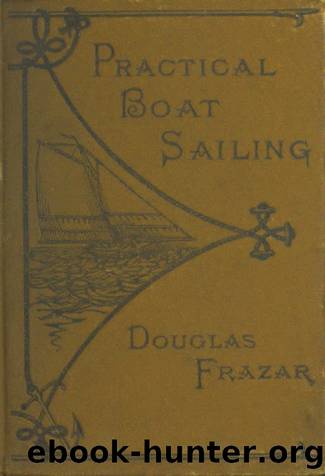Practical Boat-Sailing: A Concise and Simple Treatise by Douglas Frazar

Author:Douglas Frazar [Frazar, Douglas]
Language: eng
Format: epub, pdf
Tags: Sailing
Published: 2012-05-26T00:00:00+00:00
Example II. (see diagram Fig. 2).âPlacing the compass in front of the observer, it is found that the lighthouse bears W. by compass, and that the lightship bears S. W. by S. With these two bearings we consult the chart, and lay off the two lines by means of the parallel-rulers; and, if the chart gives the distance in miles of the lightship from the lighthouse, then, by means of a common rule of equal parts, we shall be able to measure the distance of the yacht from the lighthouse or from the lightship. At the foot of most charts, however, will be found a scale of miles, and, having once ascertained the exact position of the yacht by means of cross-bearings, it will be very easy, with a pair of dividers, to find its distance in miles from any desired object within view, or designed upon the chart, and, by the use of the parallel-rulers, the course, by compass, that should be sailed to reach any desired point.
It is often useful to know how many geographical or nautical miles, which measure at the equator 6,086.4 feet in length, are contained in a degree of longitude at different latitudes; that is to say, a degree of longitude east or west of 89° N. latitude is only 1.05 nautical mile in length; and yet, in another sense, this 1.05 is 60 miles, or one degree in length: hence the following table:â
A TABLE SHOWING, FOR SEVERAL DEGREES OF LATITUDE, HOW MANY MILES DISTANT THE TWO MERIDIANS ARE WHOSE DIFFERENCE OF LONGITUDE IS ONE DEGREE.
Download
Practical Boat-Sailing: A Concise and Simple Treatise by Douglas Frazar.epub
Practical Boat-Sailing: A Concise and Simple Treatise by Douglas Frazar.pdf
This site does not store any files on its server. We only index and link to content provided by other sites. Please contact the content providers to delete copyright contents if any and email us, we'll remove relevant links or contents immediately.
Astounding Stories, August, 1931 by Various Authors(208)
Historia Amoris by Edgar Saltus(193)
B-12's Moon Glow by Charles A. Stearns(190)
The Scottish Fairy Book by Elizabeth W. (Elizabeth Wilson) Grierson(154)
Euthenics, the science of controllable environment by Ellen H. (Ellen Henrietta) Richards(141)
Marie Antoinette and the Downfall of Royalty by Imbert de Saint-Amand(138)
Arsene Lupin vs. Herlock Sholmes by Maurice Leblanc(134)
Cottage Economy, to Which is Added The Poor Man's Friend by William Cobbett(132)
A History of Witchcraft in England from 1558 to 1718 by Wallace Notestein(132)
The Courtship of Morrice Buckler by A. E. W. Mason(127)
Humphrey, Duke of Gloucester: A Biography by Kenneth Hotham Vickers(126)
Memoirs of a Veteran: Personal Incidents, Experiences and Observations by Isaac Hermann(126)
The Black Douglas by S. R. Crockett(120)
Folk-Tales of the Khasis by Mrs. Rafy(120)
Working Women of Japan by Sidney Lewis Gulick(118)
Behind The Black Dome: An Advantage Player's Guide to Casino Surveillance by T. Dane(114)
Astounding Stories, August, 1931 by Various(112)
Love-Letters Between a Nobleman and His Sister by Aphra Behn(109)
The Dangerous Classes of New York, and Twenty Years' Work Among Them by Charles Loring Brace(105)
